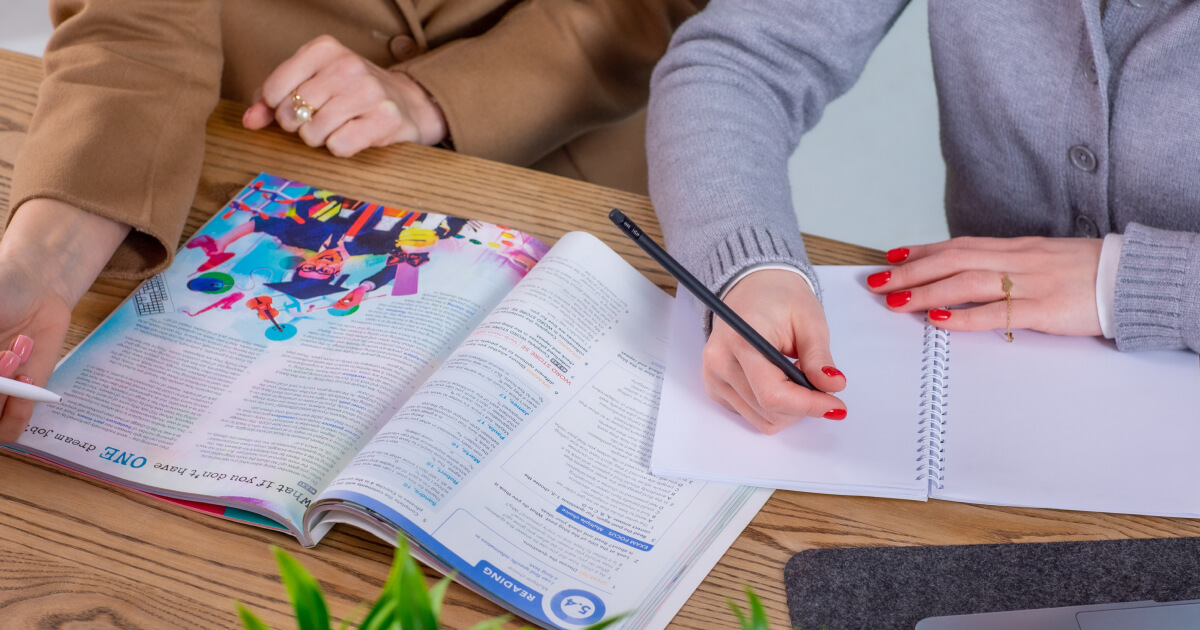7 tips for teaching IELTS writing
- Writing
- IELTS
- Tips & Strategies

29.04.2025
Reading is a foundational skill in language learning, and while coursebooks provide a range of dialogues and texts, these are typically designed with ESL students in mind. As a result, the conversations often feel unnatural or overly scripted, and the reading passages may lack the authenticity needed to truly engage learners.
When we talk about authentic reading materials, books, newspapers, and magazines might come to mind first. These are excellent resources for more advanced learners but can be overwhelming for those just starting out. It is a great idea to prepare your students for real case scenarios and give them authentic pieces of reading material.
Before doing that I recommend surveying your students on the subjects they have the most interest in.

Unlock the secrets to successful reading lessons
Join our courseFortunately, there’s a wide variety of real-world texts that English learners at all levels can explore — and here are some great examples to get started.
Comics and graphic novels are another great way to get students interested in reading. They use both pictures and words to tell a story. Just like I mentioned previously, pictures help students guess way better than just skimming the title. This mix makes it easier for students to understand what’s happening, even if they don’t know every word.
The pictures give helpful clues, so students can guess the meaning of new words or expressions without feeling frustrated.
Comics often use everyday language and short conversations, which helps students learn how people really speak. They might also include jokes, slang, or idioms, which are fun and useful to learn. Because the stories are told in a visual way, students can follow along more easily and stay focused.
Reading comics or graphic novels can be especially helpful for students who find long texts boring or difficult. These types of books can boost confidence, improve reading skills, and make learning English more fun.
Not only are they good for teenagers but also for adult learners.
Some people may not find instruction manuals very exciting, but they can be very useful for certain students — especially those who are interested in how things work. Manuals for gadgets like phones, kitchen tools, or electronics can be great reading practice.
These texts show students how to follow steps, which helps them understand how to read instructions in English. Manuals also include special words related to machines, buttons, or settings. This kind of language is very practical, and students might even use it in real life.
Using Digital Comics in Teaching ESL Writing
Reading instruction manuals helps students build both their reading skills and their ability to do real-world tasks. It’s a good way to learn technical words and how to give or follow directions in English.
Local or community newspapers are a great way for students to learn about what’s happening around them. These newspapers talk about news, events, and stories from the area where they live. This helps students understand the local culture and feel more connected to the community.
You can choose easy or interesting sections — like weather, sports, or community events — to match the students' level. Reading newspapers also helps students practice useful reading skills, like skimming (reading quickly to get the main idea) and scanning (looking for specific information).
Even reading short articles or headlines can help students grow their vocabulary and learn how English is used in real life. It’s a practical and meaningful way to improve reading.
Not only for sophisticated minds, poetry can be a fun and creative way to learn English. Even short poems can help students hear the sounds and rhythm of the language. Reading poems out loud helps with pronunciation and listening skills because students start to notice how words sound together.
Poetry helps students connect with English on a deeper level, not just through rules and grammar, but through feeling, sound, and imagination.

Short stories for ESL students of all levels
Read nowTravel brochures are a rich and engaging resource for ESL learners. Personally my top favorite. They are full of colorful images, exciting descriptions, and useful information about different places around the world. Using travel brochures in the classroom allows students to explore new countries, cities, and cultures — sometimes ones they’ve never heard of before.
This type of material is especially helpful for practicing descriptive language. Brochures often include words that describe landscapes, weather, activities, food, and local customs. Students can learn how to use adjectives more effectively and build sentences that create a vivid picture. For example, instead of just saying “nice beach,” they might learn to say “a peaceful, white-sand beach with clear blue water.”
A great classroom activity is asking students to plan a pretend vacation using a brochure. They can choose a destination, describe what they would do there, and explain why they want to go.
This encourages them to use new vocabulary, practice speaking or writing in full sentences, and improve their geographical knowledge at the same time.
Exploring restaurant menus and cooking recipes can be a highly enjoyable and educational experience for ESL students. And it is officially my second favorite (just because I can get very hungry while talking about food). These everyday texts are rich in practical vocabulary, especially related to food, ingredients, and preparation methods.
Whether reading a menu from a local café or following a simple recipe, students are exposed to real-life language in context.
Menus teach students how to identify different types of dishes, understand categories like appetizers, main courses, and desserts, and become familiar with common adjectives used to describe food (e.g., spicy, grilled, creamy).
Recipes, on the other hand, are perfect for learning action verbs (like chop, mix, bake), time expressions, and measurements — all of which are important in real-world communication.
Following a recipe also helps students develop sequencing and comprehension skills, as they must follow steps in the correct order to complete the task successfully. You can even turn this into a hands-on activity by having students bring in a favorite recipe to share or explain how to prepare a dish from their culture.
How to Teach English to Adults
Effective Tips and Activities for ESL Teachers
Magazine or online advertisements are often overlooked as reading materials, but they offer a wealth of language and cultural insight for your students.
These texts are usually short, visually engaging, and packed with persuasive language meant to catch attention and influence people’s decisions. This makes them perfect for analyzing how language is used in real-world communication.
Advertisements are full of rhetorical devices, catchy slogans, emotional appeals, and exaggeration. Exploring these elements helps students understand the techniques marketers use to persuade people — and teaches them to be more aware of language in the media.
For example, phrases like “limited-time offer,” “best value,” or “you deserve it” can open up discussions about advertising strategies and how they differ between cultures.
In addition, ads often reflect the values, trends, and priorities of a society. Talking about what is being sold, how it's presented, and who the target audience is can lead to meaningful conversations about cultural differences and social norms. Students not only improve their reading and vocabulary but also sharpen their critical thinking skills.
Music is often called a universal language — and for good reason. Studying song lyrics in the ESL classroom is not only enjoyable, but also highly effective for language learning. Songs expose students to natural speech, including rhythm, intonation, and informal language that may not appear in textbooks.
By listening closely and reading along with the lyrics, students improve their listening skills while developing a better ear for how English is spoken in everyday contexts.
Song lyrics often include
helping learners become more familiar with the way native speakers communicate. In addition, songs are rich with emotion and cultural references, making them a great starting point for classroom discussions.
However, it’s important to be mindful when selecting songs for your lessons. Many songs may contain strong language, controversial political messages, or other sensitive content. Personally, I prefer to steer clear of such topics in the classroom.
That said, if your group is open-minded and comfortable discussing a wide range of subjects without conflict, feel free to explore them. Just make sure the content aligns with your students’ preferences and the overall classroom environment.
Last but certainly not least, the internet provides an almost endless supply of blogs, articles, and opinion pieces covering a wide range of topics — from science and technology to mental health, personal development, travel, and hobbies.
This type of content is especially valuable because it reflects real, current language use and allows students to engage with topics they genuinely care about. Whether a student is interested in photography, fitness, or environmental issues, there’s something online that speaks directly to their interests.
Encouraging students to explore such materials not only enhances reading fluency but also promotes independent, self-directed learning. As they read outside the classroom, students develop confidence in their ability to navigate English-language content in everyday life.
In addition, reading online helps build digital literacy — a vital skill in today's world where so much information and communication happens through digital platforms.
Incorporating non-traditional reading materials into ESL instruction opens up a world of possibilities for both teachers and students. From comics and menus to song lyrics, travel brochures, and online articles, these resources bring language to life in ways that textbooks alone cannot.
They reflect real-world language use, spark curiosity, and connect learning to students’ everyday experiences and personal interests.
By offering diverse and meaningful reading experiences, you can foster not just literacy, but also creativity, critical thinking, cultural awareness, and a genuine love for learning. When students see the value and joy in reading, they become more confident, more independent, and more connected to the world around them.
At the end of the day, it’s not just about what students read — it’s about what they take away from the experience.
Solomiia Korchynska
Author
Teacher of General & Business English
Comments
Leave your comment